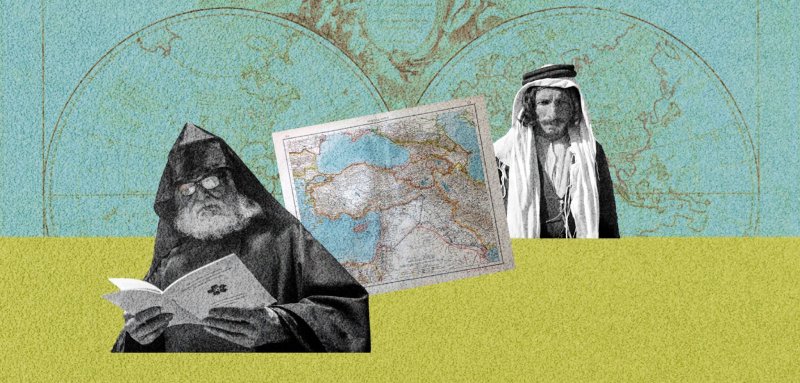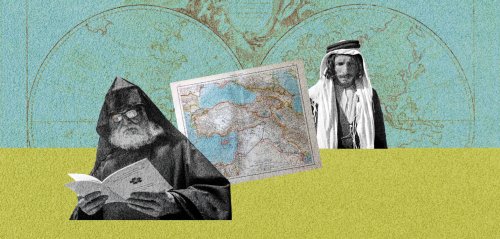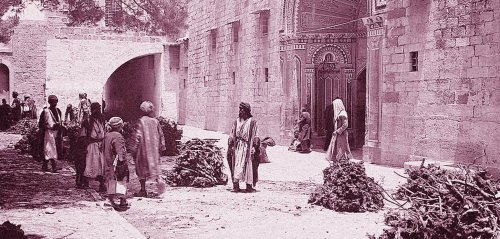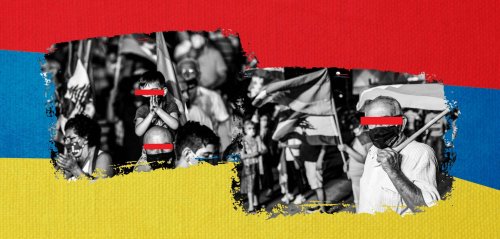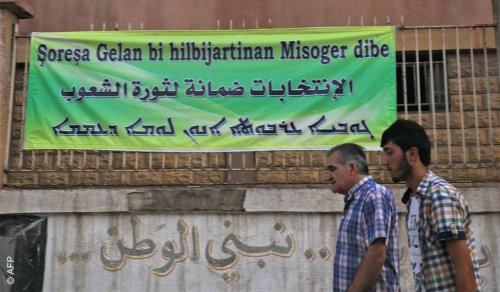During the middle of World War I, Ahmed Izzat Al-Ustad, the secretary of Sultan Muhamed Rashad V, embarked on a tour of all Syrian cities, eventually making a stop in Hama. Here, he saw gatherings of Armenian families, displaced and fleeing from the cruelties and massacres committed against them. Inside a mosque in Hama, he came across a young girl of unknown identity, who spoke only Armenian and Turkish. Ahmed Ezzat fell in love with her and married her after she converted to Islam at his behest. He then gave her the name "Hasniyya". Unfortunately, Hasniyya's life was short, and she passed away a decade later, but not before bearing children, one of whom was Bahjat Al-Ustad, who became known as a radio singer in Damascus, and his sister (my grandmother) who passed away in 2001.
I came to know this part of my mother's family history later in life, and it may well account for the profound empathy and respect I hold for Syria's Armenian community. They have been my friends since my university days at the American University in Beirut, and one of my closest associates hails from the Armenian community in Aleppo that resettled in Damascus. We spent many hours delving into discussions on the "Armenian cause", the history of Armenians in the Levant, and the Secret Army for the Liberation of Armenia, which formed an alliance with the Palestinian Liberation Organization during Lebanon's civil war. They even established joint training bases in the Bekaa Valley. My friend greatly admired Yasser Arafat and often recounted the story of Arafat's response when he was asked about his ties to the Armenians: "Really, don't you know that my name is Yasser Arafatian?"
Between Jerusalem and Beirut
Armenians have been dispersed across the countries of the Arab Levant since the onset of the massacres against them in the early twentieth century. However, their presence in Palestine dates back to the fifth century. By 1948, their population in Palestine had swelled to 15,000, yet today, it has dwindled to around 5,000, with approximately 1,000 residing in Israel.
Lebanon witnessed a minor Armenian presence until the early twentieth century. However, their numbers rapidly surged after they arrived there as refugees fleeing the Ottoman massacres, and settled in villages in the Bekaa Valley and the Metn region.
In the Old City of Jerusalem, there is a renowned Armenian neighborhood that has remained unchanged by Israel. It has withstood Israel's attempts at demolition or alteration of its demographic makeup. The Armenians clung to their neighborhood, refusing to depart on the day of Nakba in 1948. Nevertheless, many were displaced in subsequent years, whether during the 1967 war or the First and Second Intifadas.
In Lebanon, the Armenian presence was far more pronounced and influential. They were permitted to establish their political parties and educational institutions. Additionally, the famous Haigazian University in Beirut emerged as a notable institution. Originally founded as an educational institute in 1955, it later blossomed into a respected and prestigious university in the 1990s. Today, Armenians in Lebanon wield substantial political power, forming an integral component of the Lebanese political landscape. Key parties, such as the Tashnag Party and the Hunchakian Party, hold as many as six parliamentary seats and two representatives in the government.
Lebanon witnessed a minor Armenian presence until the early twentieth century. However, their numbers rapidly surged after they arrived there as refugees fleeing the Ottoman massacres, and settled in villages in the Bekaa Valley and the Metn region, ultimately establishing a thriving neighborhood in Beirut that still exists to this day, commonly referred to as Bourj Hammoud.
Armenians have been dispersed across the countries of the Arab Levant since the onset of the massacres against them in the early twentieth century. However, their presence in Palestine dates back to the fifth century
During the Lebanese Civil War, Armenians in Lebanon entrenched themselves in their neighborhoods and refused to take up arms, aligning neither with the Muslim supporters of the Palestinian Liberation Organization nor with the major Christian parties like the Kataeb and the Lebanese Forces. Whenever any of the warring factions approached them, they either expelled or eliminated them, allowing them to maintain their neutrality until the end of the civil war.
Prominent figures among them include Karim Bakradouni, the former head of the Kataeb Party, the renowned writer and media figure Mariam Noor, and the musician Guy Mannoukian. Lebanon has not conducted a population census since the 1930s, but media estimates currently place the Armenian population at around 150,000. However, many have emigrated due to Lebanon's severe economic decline in recent years, exacerbated by the Beirut port explosion on August 4, 2020, which claimed over 240 lives, including 15 Armenians.
The Armenians of Syria
The migration of Armenians in neighboring Syria followed a similar pattern, with their numbers peaking around the time of independence in 1946 when they reached nearly 400,000. However, their population dwindled over the years, reaching what we believed to be a minimum in 2011, with around 100,000 Armenians distributed as follows: 70,000 in Aleppo, 20,000 in Qamishli, and approximately 6,000 in Damascus.
Armenians in Syria did not have any political parties even into the 1950s, although the activities of the Tashnag were recognized by the Syrian state before the union with Egypt in 1958. They had three deputies in the parliament during the French mandate, from Antakya and Aleppo. However, in 1943, they exchanged one of these seats for Armenian representation in Damascus, and the well-known contractor Nazareth Yacoubian was elected as a deputy on President Shukri al-Quwatli's list.
Yacoubian played a key role in restoring and rebuilding the Syrian parliamentary council, after it had been bombed by the French in 1945. During the period of independence, Armenians participated in writing the 1950 constitution, and two of them attained high-ranking positions in the Syrian state: Hrant Manolian (1896-1978), the Commander-in-Chief of the Gendarmerie during al-Quwatli's presidency, and Aram Karamanoukian (1910-1996), one of the founding fathers of the Syrian Army, who assumed command of the artillery in the early 1950s.
We cannot precisely determine how many Armenians remain in Syria today, with estimates suggesting no more than 10-12 thousand scattered between Damascus and Aleppo. They still maintain limited parliamentary representation since the inception of modern Syria
It's essential to take a moment here to reflect on these two individuals, among the most overlooked Armenians in the Arab world. Manolian, renowned as "Hrant Bey" or "Hrant Pasha", assumed authority over Syria during the turmoil accompanying the withdrawal of Arab forces from Palestine. He inherited the General Security service from a chaotic state left by France but managed to reorganize and expand it, increasing its forces from 5,200 to 9,800 by 1949. During his tenure, he either discharged or detained at least 400 members of the internal security forces. After retiring, he worked as an agent for British Airways in Damascus.
At the end of his life, Hrant Bey immigrated to the United States, where he passed away in 1978. Likewise, his colleague Aram Karamanoukian abandoned politics, pursued studies at the Sorbonne University, and eventually relocated to the United States, where he spent his final years.
Karamanoukian had participated in the 1948 First Arab-Israeli War, earning the Medal of Courage from President al-Quwatli. Following his military discharge, he was elected as a representative for Aleppo in the parliamentary council in 1961. Today, we cannot precisely determine how many Armenians remain in Syria, with estimates suggesting a population of no more than 10 to 12 thousand, scattered between Damascus and Aleppo. They still maintain limited parliamentary representation, but they have not reached ministerial positions in Damascus since the inception of modern Syria. It's noteworthy that several Armenians have gained significant fame and acclaim in creative fields far removed from politics, including the late media personality Mehran Youssef, the singer Lena Chamamyan, and the renowned artist Salloum Haddad.
Raseef22 is a not for profit entity. Our focus is on quality journalism. Every contribution to the NasRaseef membership goes directly towards journalism production. We stand independent, not accepting corporate sponsorships, sponsored content or political funding.
Support our mission to keep Raseef22 available to all readers by clicking here!
Interested in writing with us? Check our pitch process here!
